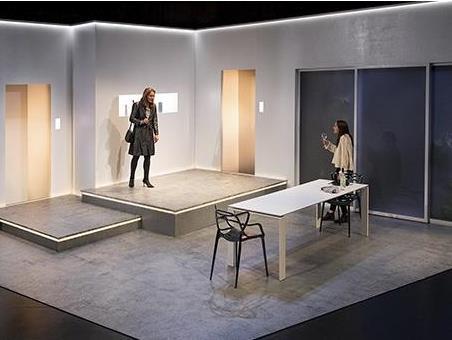Theresa (Anni Finsterer) is the inventor of The Drum – a device which connects billions of users and has revolutionised how humans interact. She is a caricature of a businesswoman – self-serving and calculating, sarcastic and superior, and in her world, there is a technological solution to every human problem – even death. Her daughter, Eva (Elizabeth Nabben), challenges this perspective. Eva reflects nostalgically on a time before The Drum, when it was just Theresa, Eva and a Tasmanian salmon dinner. One night, on a family retreat to Theresa’s home town in the country, Eva puts the ultimate challenge to Theresa. “What would you do if I died?” Theresa doesn’t need a second to think about her answer. “I would clone you,” she answers, half jokingly, thus motivating Eva’s mysterious disappearance.
Julian Larnach’s exploration into a world driven by technology is engaging enough. There is enough intrigue and suspense in the initial antagonism to make for entertaining theatre, and the action is well-paced throughout. Unfortunately, there are some fundamental problems with the story that result in In Real Life lacking the impact it was seeking.
Firstly, the treatment and perspectives explored in this story are embarrassingly outdated. These perspectives were commonplace in the 90’s at the start of the digital revolution – the over simplistic dichotomising of technology vs humanity, where technology’s very existence negates humanity. However, Larnach’s dystopian future is actually our current reality. His Drum is our iPhone. His Theresa is our Steve Jobs. And, by and large, our world is not all bad, so the entire premise of this dystopian future is a bit moot.
Theresa navigates her grief via a series of interactions with different ‘tropes’ – the back-stabby CEO of her company, her poor housekeeper, the townsfolk (who we hear about but never see), an Eva A.I., and ultimately an Eva clone. All these characters very much fall into oversimplified stereotypical dichotomies – city folk (bad) vs country folk (good), rich people (bad) vs poor people (good). Its ironic that a play that is apparently about human connection is so superficial in its treatment of human interaction, and in fact, the most intriguing scenes are the ones that foreground technology, such as the A.I. scene (which was reminiscent of an episode of Black Mirror – ‘Be Right Back’, 2013, and also borrowed from the dance scene in Ex Machina). Also ironic is Eva’s (and eventually Theresa’s) disappearance act. In shunning technology, Eva and Theresa have actually chosen an even more socially isolated alternative by disappearing into the night never to be seen again. Hence, the message of In Real Life is muddled and lost in its own contradictions.
Theresa’s journey eventually comes full circle in the final scenes where she repeats Eva’s initial anti-Drum sentiments verbatim. However, we never see this change. It occurs in an ellipse between the 3rd last and 2nd last scenes. One minute she is cloning her daughter, the next minute she is trying to convince Eva’s clone of the evils of technology. Considering what a profound 180 degree change has occurred, I felt slightly cheated at not seeing this transformation.
None of the characters are particularly well-developed, and this isn’t helped by mediocre performances. However, Georgia Hopkins’ sleek modernist set, teamed with Sian James-Holland’s lighting design and James Brown’s sound design under Luke Roger’s direction all add a much-needed gloss to the production to elevate it to a generally enjoyable experience. Just don’t interrogate the story too hard and it makes for a very palatable piece of theatre.
2 stars out of 5
In Real Life
By Julian Larnach
Director: Luke Rogers
Production Designer: Georgia Hopkins
Lighting Designer: Sian James-Holland
Sound Designer and Composition: James Brown
Stage Manager: Ryan Tate
Cast: Anni Finsterer and Elizabeth Nabben
Darlinghurst Theatre Company
15 September – 15 October 2017





